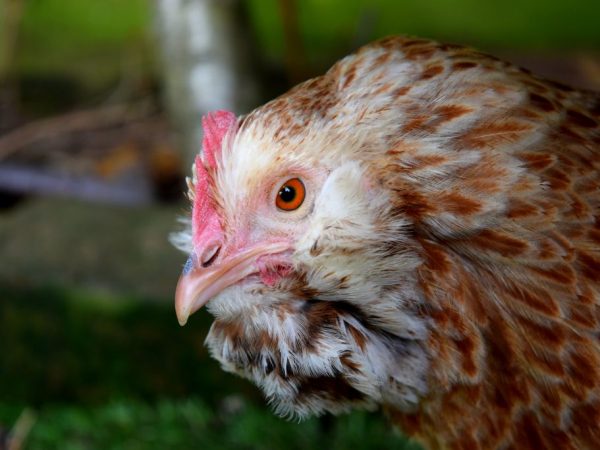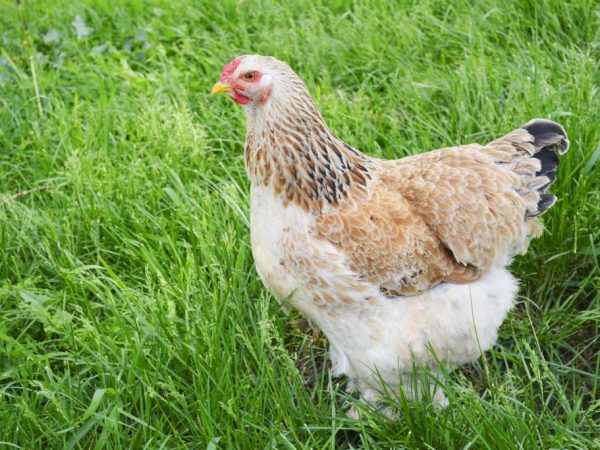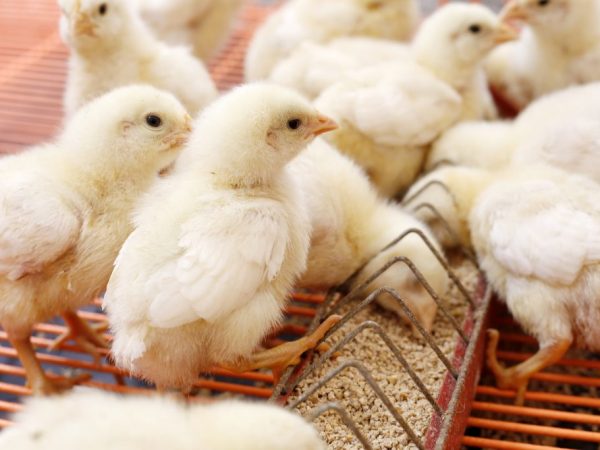Faverol hens
Among the elite varieties, the Faverol chicken breed stands out. She was taken out in France. The line is based on Mantskie chickens, Kokhinhin and Gudan. They attract attention not only by their appearance, but also by their decent taste characteristics.
- brief information
- Varieties of the breed
- Salmon
- Blue
- Dwarf
- Colombian
- Description of the breed
- The cost
- Appearance
- Character
- Incubation instinct
- Productivity
- Advantages and disadvantages
- Breeding features
- Incubation
- Chick feeding
- Chick care
- Maintenance of adults
- What should be a chicken coop
- Food
- Place for walking
- Possible diseases
- Owner reviews

Faverol hens
brief information
- Productivity type: meat and egg.
- Rooster weight: heavy (up to 4 kg).
- Chicken weight: medium-heavy (2.5-3 kg).
- Ovipositor start: early.
- Egg production: average, up to 180 eggs per year.
- Features of the: resistant to diseases, moderately whimsical to care for.
- Egg size: medium (50 g).
- Are they suitable for a beginner: Yes.
Varieties of the breed
As a result of selection, several subspecies of this variety were obtained. Consider the description of each.
The main symbol of any bird's belonging is the presence of brown spots on the rooster in the neck area.
Salmon
The color of the feathers in chickens is light, in roosters - black, with the addition of beige.
It is because of the attractiveness of males that Faverol is considered a beautiful breed.
Sometimes a mixture of salmon shade with white-red, white, turquoise and other colors can be found. Birds with an ermine color are also distinguished.
Blue
The variety is fixed within the framework of the standard. Often, the blue tint of the plumage is combined with salmon, there are also white individuals with a blue admixture.
This breed is much less common, so its cost is slightly higher. The color does not affect the productive characteristics in any way.
Dwarf
German breeders managed to get a dwarf variety of chickens. They weigh up to 1 kg, and their egg production rates are lower.
Otherwise, the bird looks the same as a regular faverole. There are significant differences in behavior - the character is more energetic.
Colombian
Both hens and roosters have the same plumage: almost the entire length of the feather is white, and its end is painted black. But in the male it is distinguished by its splendor and in size it is slightly larger.
Description of the breed

Chickens need sunlight
Faverol chickens are raised for sale in the meat and egg direction. Egg production is good, it starts early.
Birds are able to quickly gain muscle mass, but for this they need certain conditions.
The trough should always have fresh and clean food, as well as access to sunlight, so they need to walk more often in the air.
The cost
Faverol chickens are rare, but they are in demand.
Chicken up to 10 days old can be bought for 300 rubles and more. The price of an adult chicken or rooster will be at least 5,000 rubles.
Appearance
All representatives of the breed have common features by which they are easy to identify.
The head is small in size, slightly flattened. The beak is powerful, but short, it can be of different colors: from pale yellow to pinkish or white.
The ridge is leaf-shaped, erect.All teeth are even, rather high.
The eyes of chickens are small, orange-red. The neck is not long, on it a loose, but lush plumage creates a mane that smoothly passes onto the back.
There is always a collar near the base of the head, formed thanks to the feathers, which are located in the direction of the back of the head.
The ribcage is rounded, protrudes slightly forward. The wings are high, the paws are well developed, they are covered with good plumage (this is the peculiarity of this breed).
The feathers are lush, soft in structure. The abundant fluff prevents freezing, so in the winter, if there is no snow, you can let the birds outside.
The weight of males often reaches 4 kg. This indicator depends on the quality of the feed. Chickens are slightly smaller, up to 3 kg.
Character
Faverolle has an inquisitive but docile temperament. They get used to the owner relatively quickly and are able to recognize it.
Incubation instinct
In adult representatives of this species, the instinct for incubation is poorly developed. We can say that it was completely lost. For hatching young animals, you cannot do without special incubators.
The offspring always surprises with their activity and large size. Chicks are not prone to disease. From the very first days they have an excellent appetite, they grow quickly.
Productivity
Chickens always start early to lay. During the first year, one hen may well lay 180 eggs: productivity is above average. But already for 2 years, the indicators are reduced to 130 pieces.
The eggs are small, the shell is brown, the yolk is large.
Advantages and disadvantages

Birds have a calm disposition
Among the advantages, the following qualities are distinguished:
- good performance indicators;
- calm temperament;
- beautiful and aesthetic appearance.
The main disadvantages are considered only the high cost of birds, the obligation of daily cleaning in the poultry house.
Breeding features
The most suitable period for hatching chicks falls in February.
To prevent the degeneration of the variety, it is necessary to keep a rooster and at least 5 chickens from different lines. This will avoid various health problems of the offspring and a decrease in the level of productivity.
In the spring, chickens can already safely go for a walk. With the beginning of the summer season, the egg production period begins.
Incubation
For breeding, eggs are taken from hens that are already 1 year old. They are placed in a place with a temperature not exceeding 10 ° C. Such conditions are provided for about 2 weeks.
It is important to always maintain certain indicators. Even with the smallest deviation, the chicks' toes can be twisted on the legs. The most suitable setting is 37.6 ° C.
Chicks from eggs hatch after 22 days. They must be placed immediately on a dry mat.
It must be warm. The temperature is 38 ° C. If the weather is cloudy, you cannot do without additional lighting.
Chicks feeding
During the first 10 days, chickens need to be given boiled and well-chopped eggs, porridge (preferably corn), and cottage cheese. They begin to introduce food on the 11th day, but this should be done gradually.
The intervals between meals at different stages of development change.
The first month they feed up to 8 times (observe the same interval). On the second - 4 times. Then it becomes stable - three times a day.
Chick care
It takes a lot of effort to care for chickens.
It is important to prepare the place of detention: choose a clean and warm room, where it is dry, fresh air always circulates, but there are no through streams.
More than 25 chicks cannot be placed on an area of 1 m². There should be plenty of free space for each of them.
For 5 days after birth, keep the chickens on the floor, which is previously covered with paper. Pour food and some cereals on it. This approach will allow babies to receive food without any health risks.

Chicks must be well cared for
For 1 chick, 50 g of cereals and cottage cheese are isolated.
The floor should not be cold: there is a possibility that the birds can get sick. Since their bodies are still weak at this age, it will be extremely difficult to cope with the disease, many of them die as a result of infections.
Keeping adults
The productivity and health of the birds depends on how good the conditions for keeping are created.
What should be a chicken coop
Choose a spacious room. If you neglect this, the chicks will simply begin to trample on the food, it will become unusable, and there is also the possibility of injury.
The humidity level should be regulated as chickens do not tolerate it. Feeders are always hung above the floor, otherwise they will scatter food.
It is better to keep no more than 15 heads in the chicken coop. You can not keep Faverol in the same room with any other breed. So the birds will be calm, there will be no unnecessary factors that can affect productivity.
Food
The diet should be balanced. Use compound feed or dry feed. Remember that wet food can ruin the feathers.
In this case, the birds can begin to peck it, causing injury to themselves and their neighbor. During the summer season, a third of all feed should be greens. Pay special attention to legumes, oats with wheat, dandelions, clover, nettle, woodlice. After a walk, you will need additional feeding in the form of compound feed.
Chickens should not be allowed to eat nightshade, crocus, hellebore - these herbs contain poison. For a day, one individual needs up to 150 g of feed. In the case of obesity, the daily rate is reduced by almost half - up to 80 g.
With the arrival of winter and spring, greens are replaced with well-sprouted ears of wheat, carrots, pumpkins, spruce or pine needles. You can give zucchini, nettles, but only steamed. Pay attention to vitamins.
If productivity drops, add oatmeal (raw) to your diet. In winter, wet food must be warmed up. If the food is combined, then dry food is alternated with wet food, and the number of meals is 3-4 times.
Place for walking
Walking helps to strengthen the immunity of birds and prevents obesity. This breed loves to eat well, so they have a high propensity for it.
Since chickens hardly fly up, too high fences are unnecessary. They will not trample the beds either. The main thing is to choose a spacious place.
Possible diseases
Representatives of the Faverol breed have a high resistance to diseases. Chicks have no immunity, but with proper care, the risk of disease will be minimal.
The main danger is the litter. It should never be wet. If this point is neglected, birds can not only lose their ability to carry eggs normally, but even die altogether.
Owner reviews
Faverol chicken is an excellent meat variety, according to a large number of farmers. She also has good egg production, making the maintenance really profitable.
Buying livestock is not always easy. This is due not only to the high cost, but also not too widespread.

